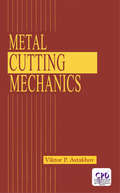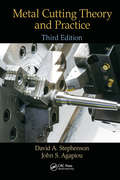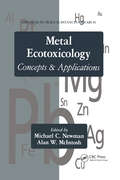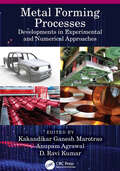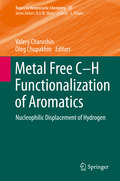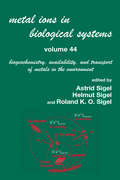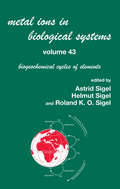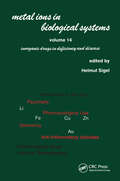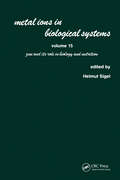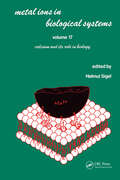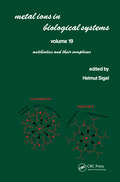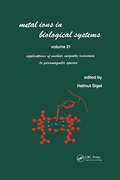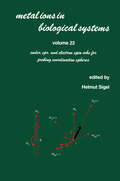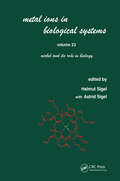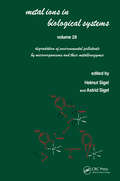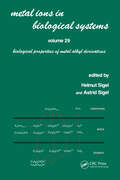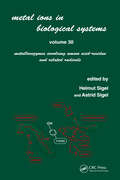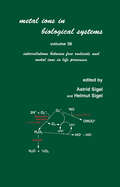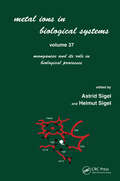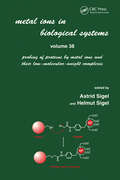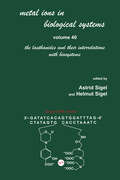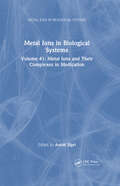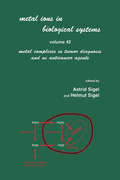- Table View
- List View
Metal Cutting Mechanics
by Viktor P. AstakhovMetal Cutting Mechanics outlines the fundamentals of metal cutting analysis, reducing the extent of empirical approaches to the problems as well as bridging the gap between design and manufacture. The author distinguishes his work from other works through these aspects:considering the system engineering of the cutting process id
Metal Cutting Theory and Practice
by David A. Stephenson John S. AgapiouA Complete Reference Covering the Latest Technology in Metal Cutting Tools, Processes, and Equipment Metal Cutting Theory and Practice, Third Edition shapes the future of material removal in new and lasting ways. Centered on metallic work materials and traditional chip-forming cutting methods, the book provides a physical understanding of conventional and high-speed machining processes applied to metallic work pieces, and serves as a basis for effective process design and troubleshooting. This latest edition of a well-known reference highlights recent developments, covers the latest research results, and reflects current areas of emphasis in industrial practice. Based on the authors’ extensive automotive production experience, it covers several structural changes, and includes an extensive review of computer aided engineering (CAE) methods for process analysis and design. Providing updated material throughout, it offers insight and understanding to engineers looking to design, operate, troubleshoot, and improve high quality, cost effective metal cutting operations. The book contains extensive up-to-date references to both scientific and trade literature, and provides a description of error mapping and compensation strategies for CNC machines based on recently issued international standards, and includes chapters on cutting fluids and gear machining. The authors also offer updated information on tooling grades and practices for machining compacted graphite iron, nickel alloys, and other hard-to-machine materials, as well as a full description of minimum quantity lubrication systems, tooling, and processing practices. In addition, updated topics include machine tool types and structures, cutting tool materials and coatings, cutting mechanics and temperatures, process simulation and analysis, and tool wear from both chemical and mechanical viewpoints. Comprised of 17 chapters, this detailed study: Describes the common machining operations used to produce specific shapes or surface characteristics Contains conventional and advanced cutting tool technologies Explains the properties and characteristics of tools which influence tool design or selection Clarifies the physical mechanisms which lead to tool failure and identifies general strategies for reducing failure rates and increasing tool life Includes common machinability criteria, tests, and indices Breaks down the economics of machining operations Offers an overview of the engineering aspects of MQL machining Summarizes gear machining and finishing methods for common gear types, and more Metal Cutting Theory and Practice, Third Edition emphasizes the physical understanding and analysis for robust process design, troubleshooting, and improvement, and aids manufacturing engineering professionals, and engineering students in manufacturing engineering and machining processes programs.
Metal Ecotoxicology Concepts and Applications (Advances In Trace Substances Research Ser. #2)
by Michael C. Newman Alan W. McIntoshThis book provides an in-depth discussion of various aspects of metal ecotoxicology. State-of-the-art information and techniques in areas ranging from metal behavior in surface waters to bioaccumulation kinetics and toxicokinetics to community effects are presented in a hierarchical arrangement. Specific topics discussed include metals in abiotic components of ecosystems, autecology (effects of metals relative to the individual or a single species), and metals in marine and freshwater systems in the context of synecology (species associated and interacting as a unit). This is an important book that will be useful to researchers, risk assessment consultants, regulatory personnel, and teachers and students.
Metal Forming
by William F. Hosford Robert M. CaddellThis book helps the engineer understand the principles of metal forming and analyze forming problems - both the mechanics of forming processes and how the properties of metals interact with the processes. In this fourth edition, an entire chapter has been devoted to forming limit diagrams and various aspects of stamping and another on other sheet forming operations. Sheet testing is covered in a separate chapter. Coverage of sheet metal properties has been expanded. Interesting end-of-chapter notes have been added throughout, as well as references. More than 200 end-of-chapter problems are also included.
Metal Forming Processes: Developments in Experimental and Numerical Approaches
by Anupam Agrawal Kakandikar Ganesh Marotrao D. Ravi KumarMetal forming processes include bulk forming and sheet metal forming with numerous applications. This book covers some of the latest developments aspects of these processes such as numerical simulations to achieve optimum combinations and to get insight into process capability. Implementation of new technologies to improve performance based on Computer Numerical Control (CNC) technologies are also discussed, including the use of CAD/CAM/CAE techniques to enhance precision in manufacturing. Applications of AI/ML, the Internet of Things (IoT), and the role of tribological aspects in green engineering are included to suit Industry 4.0. Features: • Covers latest developments in various sheet metal forming processes • Discusses improvements in numerical simulation with various material models • Proposes improvements by optimum combination of process parameters • Includes finite element simulation of processes and formability • Presents a review on techniques to produce ultra-fine-grained materials This book is aimed at graduate students, engineers, and researchers in sheet metal forming, materials processing and their applications, finite element analysis, manufacturing, and production engineering.
Metal Free C-H Functionalization of Aromatics
by Valery Charushin Oleg ChupakhinThe series Topics in Heterocyclic Chemistry presents critical reviews on present and future trends in the research of heterocyclic compounds. Overall the scope is to cover topics dealing with all areas within heterocyclic chemistry, both experimental and theoretical, of interest to the general heterocyclic chemistry community. The series consists of topic related volumes edited by renowned editors with contributions of experts in the field.
Metal Ions In Biological Systems, Volume 44: Biogeochemistry, Availability, and Transport of Metals in the Environment
by Helmut Sigel Roland SigelVolume 44, devoted solely to the vital research areas concerning the biogeochemistry of metals and their transport in the environment and availability to living systems, offers 9 timely and authoritative chapters on these fascinating topics by 19 internationally recognized experts.
Metal Ions in Biochemistry: 2nd Edition
by Pabitra Krishna Bhattacharya Prakash B. SamnaniThe second edition of Metal Ions in Biochemistry deals with the multidisciplinary subject of bio-inorganic chemistry, encompassing the disciplines of inorganic chemistry, biochemistry and medicine. The book deals with the role of metal ions in biochemistry, emphasising that biochemistry is mainly the chemistry of metal-biochemical complexes. Hence, the book starts with the structures of biochemicals and the identification of their metal binding sites. Thermodynamic and kinetic properties of the complexes are explained from the point of view of the nature of metal-ligand bonds. Various catalytic and structural roles of metal ions in biochemicals are discussed in detail. Features The role of Na+ and K+ in brain chemistry. The role of zinc insulin in glucose metabolism and its enhancement by vanadium and chromium compounds. Discussion of the role of zinc signals, zinc fingers and cascade effect in biochemistry. Haemoglobin synthesis and the role of vitamin B12 in it. The role of lanthanides in biochemical systems. A detailed discussion of the role of non-metals in biochemistry, a topic missing in most of the books on bio-inorganic chemistry. The study of bio-inorganic chemistry makes biochemists rethink the mechanistic pathways of biochemical reactions mediated by metal ions. There is a realisation of the role of metal complexes and inorganic ions as therapeutics such as iron in leukaemia, thalassemia and sickle cell anaemia, iodine in hypothyroidism and zinc, vanadium and chromium in glucose metabolism. The most recent realisation is of the use of zinc in the prevention and treatment of COVID-19.
Metal Ions in Biological Systems, Volume 43 - Biogeochemical Cycles of Elements: Volume 29: Biological Properties Of Metal Alkyl Derivatives (Metal Ions In Biological Systems Ser. #29)
by Astrid Sigel; Helmut SigelMetal Ions in Biological Systems is devoted to increasing our understanding of the relationship between the chemistry of metals and life processes. The volumes reflect the interdisciplinary nature of bioinorganic chemistry and coordinate the efforts of researchers in the fields of biochemistry, inorganic chemistry, coordination chemis
Metal Ions in Biological Systems: Volume 14: Inorganic Drugs in Deficiency and Disease
by Astrid Sigel Helmut SigelThis book describes drug metal-ion interactions in the gut and deals with the deficiency of zinc and iron and their pharmacological use. It covers anti-inflammatory activities of copper and gold complexes and considers the role of metal ions and chelating agents in anti-viral chemotherapy.
Metal Ions in Biological Systems: Volume 15: Zinc and its Role in Biology and Nutrition (Metal Ions In Biological Systems Ser. #24)
by Helmut SigelThis volume first considers the categories of zinc metalloenzymes, together with models of the enzymic metal-ion binding sites. It covers the nutritional aspects of zinc: its absorption and excretion, its influence on the activity of enzymes and hormones, and the zinc deficiency syndrome.
Metal Ions in Biological Systems: Volume 17: Calcium and its Role in Biology (Metal Ions in Biological Systems)
by Astrid Sigel Helmut SigelThis book is wholly devoted to Ca2+ metal ion, as it is so important in regulating a wide variety of biological activities. It deals with calcium and brain proteins, the role of ca2+ in exocytosis, blood coagulation, and the regulation of the skeletal muscle contraction-relaxation cycle.
Metal Ions in Biological Systems: Volume 19: Antibiotics and Their Complexes (Metal Ions in Biological Systems)
by Astrid Sigel Helmut SigelThis volume is an attempt to improve the understanding of the coordination chemistry and action of the biologically important compounds, also termed antibiotics, and to stimulate further research in this area, describing the properties of the biologically important compounds.
Metal Ions in Biological Systems: Volume 21: Applications of Magnetic Resonance to Paramagnetic Species (Metal Ions in Biological Systems)
by Astrid Sigel Helmut SigelThis book facilitates a wider use of nuclear magnetic resonance in studies of paramagnetic species. It summarizes studies of magnetically coupled metalloproteins, of paramagnetic heme proteins, and of metal-porphyrin-induced dipolar shifts for conformational analysis.
Metal Ions in Biological Systems: Volume 22: Endor: EPR, and Electron Spin Echo for Probing Coordination Spheres (Metal Ions in Biological Systems)
by Astrid Sigel Helmut SigelThis volume focuses on the physical methods to probe the coordination sphere of metal ions in biological systems, which are based on para-magnetic species, namely, the electron nuclear double resonance (ENDOR), electron paramagnetic resonance (EPR), and electron spin echo (ESE) techniques.
Metal Ions in Biological Systems: Volume 23: Nickel and its Role in Biology (Metal Ions in Biological Systems)
by Astrid Sigel Helmut SigelThis book considers nickel in the environment and in aquatic systems and outlines its role for plants. It discusses the toxicology of nickel compounds and the role of nickel in carcinogenesis, focusing on the analysis of nickel in biological materials and the related difficulties.
Metal Ions in Biological Systems: Volume 28: Degradation of Environmental Pollutants by Microorganisms and Their Metalloenzymes (Metal Ions in Biological Systems)
by Astrid Sigel Helmut SigelContinuing to explore the relationship between the chemistry of metals and life processes, this volume in the Metal Ions in Biological Systems series examines the degradation of environmental pollutants by micro-organisms. It covers the action of micro-organisms and metalloenzymes on lignin, tannins, hemicelluloses, cellulose and aromatic compounds, as well as on halogenated aromatics and aliphatics; analyzes mechanistic aspects; considers the role of metalloproteases in biotechnology and wastewater sludge treatment; and describes the metal-dependent conversion of inorganic nitrogen and sulfur compounds.
Metal Ions in Biological Systems: Volume 29: Biological Properties of Metal Alkyl Derivatives (Metal Ions in Biological Systems)
by Astrid Sigel Helmut SigelThis volume is devoted to the research area regarding the biological properties of metal alkyl derivatives, offering an authoritative account of this subject by 16 scientists. In 11 chapters, Biological Properties of Metal Alkyl Derivatives highlights, in detail, derivatives of germanium, tin, lead, arsenic, antimony, selenium, tellurium, cobalt (vitamin B12 derivatives) and nickel (coenzyme F430), including the role of (mainly) micro-organisms in their formation. The derivatives of indium, thallium, bismuth, various transition metals and mercury are also covered to some extent, as are those of the non-metals silicon, phosphorus and sulfur, and the haloperoxidase route of the biogenesis of halomethanes by fungi and plants. The properties of these alkyl derivatives, their biosynthesis, including mechanistic aspects, their appearance in waters (rivers, lakes, oceans) and sediments, and their physiological and toxic effects are summarized.
Metal Ions in Biological Systems: Volume 30: Metalloenzymes Involving Amino Acid-residue and Related Radicals (Metal Ions in Biological Systems)
by Astrid Sigel Helmut SigelThis volume is devoted solely to the research area of metalloenzymes involving amino acid-residue and related radicals. Topics covered include: general considerations; structure, function and engineering of peroxidases; and ribonucleotide reductase in mammalian systems.
Metal Ions in Biological Systems: Volume 36: Interrelations Between Free Radicals and Metal Ions in Life Processes (Metal Ions In Biological Systems Ser. #28)
by Astrid Sigel Helmut SigelContinues the tradition of excellence established in previous volumes in this acclaimed series. Volume 36 focuses on the vibrant research area concerning the interrelation between free radicals and metal ions and their resulting effects on life processes; it offers an authoritative and timely account of this fascinating area of research in 21 chapters.
Metal Ions in Biological Systems: Volume 37: Manganese and Its Role in Biological Processes (Metal Ions in Biological Systems)
by Helmut Sigel"Highlights the availability of magnesium to organisms, its uptake and transport in microorganisms and plants as well as its role in health and disease of animals and humans including its toxicology."
Metal Ions in Biological Systems: Volume 38: Probing of Proteins by Metal Ions and Their Low-Molecular-Weight Complexes (Metal Ions in Biological Systems)
by Astrid Sigel Helmut SigelVolume 38: Probing of Proteins by Metal Ions and Their Low-Molecular-Weight Complexes focuses on the vibrant area of probing enzymes or proteins by metal ions and small complexes. It offers a summary of the basic characteristics of the amide bond, emphasizing its proton and metal ion interactions, including a quantitative analysis of its hydrolysis and formation. Topics include Peptide bonds, footprinting, protein degradation, protein complexes, and protein cross-linking.
Metal Ions in Biological Systems: Volume 40: The Lanthanides and Their Interrelations with Biosystems (Metal Ions in Biological Systems)
by Astrid Sigel Helmut SigelMany may know lanthanides under the homier name of rare earth elements, but that is less used scientifically because they are, in fact, not at all rare. Highlighting fast-moving research on lanthanides and their interrelations with biosystems, this book emphasizes the recent impact of these metals in biochemical, biological, and medical research, including in magnetic resonance imaging (MRI). The first two chapters outline their abundance and distribution, chemical properties such as oxidation states and ionic radii, and their mobilization through microorganisms like bacteria and fungi. It is written by 38 internationally recognized experts and enriched with nearly 200 illustrations and 1900 references.
Metal Ions in Biological Systems: Volume 41: Metal Ions and Their Complexes in Medication (Metal Ions in Biological Systems #Vol. 41)
by Patrick Graupp Robert J. WronaMetal ions are currently used for such applications as diabetes, anti-inflammatory, rheumatoid arthritis, psychiatric, and anti-ulcer medications, using compounds of vanadium, copper and zinc, gold, lithium, and bismuth, respectively. This text explores these applications in addition to an assessment of chelation therapy, uses in environmental scie
Metal Ions in Biological Systems: Volume 42: Metal Complexes in Tumor Diagnosis and as Anticancer Agents (Metal Ions In Biological Systems Ser. #28)
by Astrid Sigel Helmut SigelOffering an authoritative and timely account by twenty-nine internationally recognized experts, Metal Ions in Biological Systems: Metal Complexes in Tumor Diagnosis and as Anticancer Agents is devoted solely to the vital research area concerning metal complexes in cancer diagnosis and therapy. In fourteen stimulating chapters, the book focuses on d
